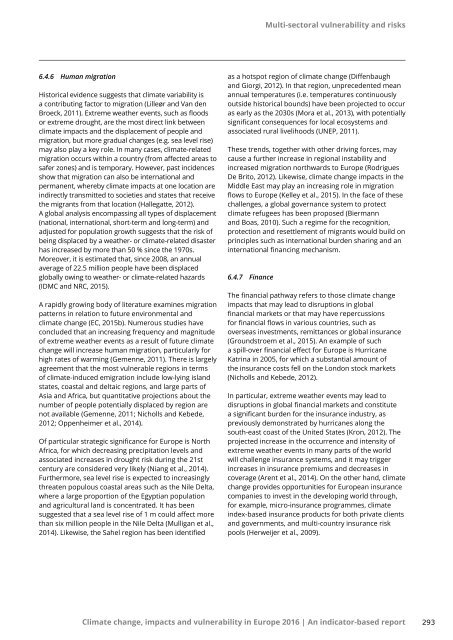Climate change impacts and vulnerability in Europe 2016
document
document
Create successful ePaper yourself
Turn your PDF publications into a flip-book with our unique Google optimized e-Paper software.
Multi-sectoral <strong>vulnerability</strong> <strong>and</strong> risks<br />
6.4.6 Human migration<br />
Historical evidence suggests that climate variability is<br />
a contribut<strong>in</strong>g factor to migration (Lilleør <strong>and</strong> Van den<br />
Broeck, 2011). Extreme weather events, such as floods<br />
or extreme drought, are the most direct l<strong>in</strong>k between<br />
climate <strong>impacts</strong> <strong>and</strong> the displacement of people <strong>and</strong><br />
migration, but more gradual <strong>change</strong>s (e.g. sea level rise)<br />
may also play a key role. In many cases, climate-related<br />
migration occurs with<strong>in</strong> a country (from affected areas to<br />
safer zones) <strong>and</strong> is temporary. However, past <strong>in</strong>cidences<br />
show that migration can also be <strong>in</strong>ternational <strong>and</strong><br />
permanent, whereby climate <strong>impacts</strong> at one location are<br />
<strong>in</strong>directly transmitted to societies <strong>and</strong> states that receive<br />
the migrants from that location (Hallegatte, 2012).<br />
A global analysis encompass<strong>in</strong>g all types of displacement<br />
(national, <strong>in</strong>ternational, short-term <strong>and</strong> long-term) <strong>and</strong><br />
adjusted for population growth suggests that the risk of<br />
be<strong>in</strong>g displaced by a weather- or climate-related disaster<br />
has <strong>in</strong>creased by more than 50 % s<strong>in</strong>ce the 1970s.<br />
Moreover, it is estimated that, s<strong>in</strong>ce 2008, an annual<br />
average of 22.5 million people have been displaced<br />
globally ow<strong>in</strong>g to weather- or climate-related hazards<br />
(IDMC <strong>and</strong> NRC, 2015).<br />
A rapidly grow<strong>in</strong>g body of literature exam<strong>in</strong>es migration<br />
patterns <strong>in</strong> relation to future environmental <strong>and</strong><br />
climate <strong>change</strong> (EC, 2015b). Numerous studies have<br />
concluded that an <strong>in</strong>creas<strong>in</strong>g frequency <strong>and</strong> magnitude<br />
of extreme weather events as a result of future climate<br />
<strong>change</strong> will <strong>in</strong>crease human migration, particularly for<br />
high rates of warm<strong>in</strong>g (Gemenne, 2011). There is largely<br />
agreement that the most vulnerable regions <strong>in</strong> terms<br />
of climate-<strong>in</strong>duced emigration <strong>in</strong>clude low-ly<strong>in</strong>g isl<strong>and</strong><br />
states, coastal <strong>and</strong> deltaic regions, <strong>and</strong> large parts of<br />
Asia <strong>and</strong> Africa, but quantitative projections about the<br />
number of people potentially displaced by region are<br />
not available (Gemenne, 2011; Nicholls <strong>and</strong> Kebede,<br />
2012; Oppenheimer et al., 2014).<br />
Of particular strategic significance for <strong>Europe</strong> is North<br />
Africa, for which decreas<strong>in</strong>g precipitation levels <strong>and</strong><br />
associated <strong>in</strong>creases <strong>in</strong> drought risk dur<strong>in</strong>g the 21st<br />
century are considered very likely (Niang et al., 2014).<br />
Furthermore, sea level rise is expected to <strong>in</strong>creas<strong>in</strong>gly<br />
threaten populous coastal areas such as the Nile Delta,<br />
where a large proportion of the Egyptian population<br />
<strong>and</strong> agricultural l<strong>and</strong> is concentrated. It has been<br />
suggested that a sea level rise of 1 m could affect more<br />
than six million people <strong>in</strong> the Nile Delta (Mulligan et al.,<br />
2014). Likewise, the Sahel region has been identified<br />
as a hotspot region of climate <strong>change</strong> (Diffenbaugh<br />
<strong>and</strong> Giorgi, 2012). In that region, unprecedented mean<br />
annual temperatures (i.e. temperatures cont<strong>in</strong>uously<br />
outside historical bounds) have been projected to occur<br />
as early as the 2030s (Mora et al., 2013), with potentially<br />
significant consequences for local ecosystems <strong>and</strong><br />
associated rural livelihoods (UNEP, 2011).<br />
These trends, together with other driv<strong>in</strong>g forces, may<br />
cause a further <strong>in</strong>crease <strong>in</strong> regional <strong>in</strong>stability <strong>and</strong><br />
<strong>in</strong>creased migration northwards to <strong>Europe</strong> (Rodrigues<br />
De Brito, 2012). Likewise, climate <strong>change</strong> <strong>impacts</strong> <strong>in</strong> the<br />
Middle East may play an <strong>in</strong>creas<strong>in</strong>g role <strong>in</strong> migration<br />
flows to <strong>Europe</strong> (Kelley et al., 2015). In the face of these<br />
challenges, a global governance system to protect<br />
climate refugees has been proposed (Biermann<br />
<strong>and</strong> Boas, 2010). Such a regime for the recognition,<br />
protection <strong>and</strong> resettlement of migrants would build on<br />
pr<strong>in</strong>ciples such as <strong>in</strong>ternational burden shar<strong>in</strong>g <strong>and</strong> an<br />
<strong>in</strong>ternational f<strong>in</strong>anc<strong>in</strong>g mechanism.<br />
6.4.7 F<strong>in</strong>ance<br />
The f<strong>in</strong>ancial pathway refers to those climate <strong>change</strong><br />
<strong>impacts</strong> that may lead to disruptions <strong>in</strong> global<br />
f<strong>in</strong>ancial markets or that may have repercussions<br />
for f<strong>in</strong>ancial flows <strong>in</strong> various countries, such as<br />
overseas <strong>in</strong>vestments, remittances or global <strong>in</strong>surance<br />
(Groundstroem et al., 2015). An example of such<br />
a spill‐over f<strong>in</strong>ancial effect for <strong>Europe</strong> is Hurricane<br />
Katr<strong>in</strong>a <strong>in</strong> 2005, for which a substantial amount of<br />
the <strong>in</strong>surance costs fell on the London stock markets<br />
(Nicholls <strong>and</strong> Kebede, 2012).<br />
In particular, extreme weather events may lead to<br />
disruptions <strong>in</strong> global f<strong>in</strong>ancial markets <strong>and</strong> constitute<br />
a significant burden for the <strong>in</strong>surance <strong>in</strong>dustry, as<br />
previously demonstrated by hurricanes along the<br />
south-east coast of the United States (Kron, 2012). The<br />
projected <strong>in</strong>crease <strong>in</strong> the occurrence <strong>and</strong> <strong>in</strong>tensity of<br />
extreme weather events <strong>in</strong> many parts of the world<br />
will challenge <strong>in</strong>surance systems, <strong>and</strong> it may trigger<br />
<strong>in</strong>creases <strong>in</strong> <strong>in</strong>surance premiums <strong>and</strong> decreases <strong>in</strong><br />
coverage (Arent et al., 2014). On the other h<strong>and</strong>, climate<br />
<strong>change</strong> provides opportunities for <strong>Europe</strong>an <strong>in</strong>surance<br />
companies to <strong>in</strong>vest <strong>in</strong> the develop<strong>in</strong>g world through,<br />
for example, micro-<strong>in</strong>surance programmes, climate<br />
<strong>in</strong>dex-based <strong>in</strong>surance products for both private clients<br />
<strong>and</strong> governments, <strong>and</strong> multi-country <strong>in</strong>surance risk<br />
pools (Herweijer et al., 2009).<br />
<strong>Climate</strong> <strong>change</strong>, <strong>impacts</strong> <strong>and</strong> <strong>vulnerability</strong> <strong>in</strong> <strong>Europe</strong> <strong>2016</strong> | An <strong>in</strong>dicator-based report<br />
293


